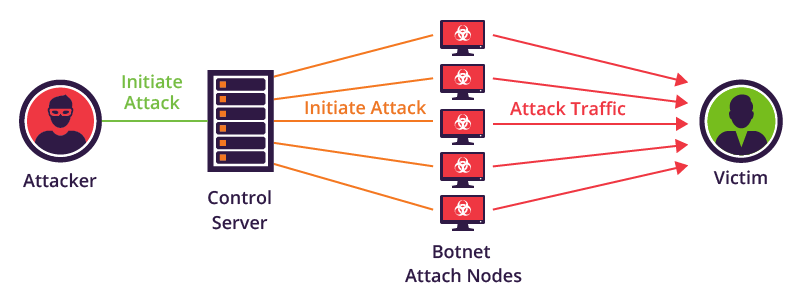What does DDoS stand for?
First, let’s define the term “DDoS.” DDoS stands for “Distributed Denial of Service.” The concept behind a targeted DDoS attack is: overwhelm a server or site’s resources in order to bring it down. There can be many reasons behind a DDoS: personal vendettas, political disputes, disagreements, getting past security or firewall barriers, or even just for “fun.”
The effects of a DDoS attack can be truly devastating. Beyond server downtime, companies can suffer brand damage, bandwidth/usage overages, and more.
How do DDoS attacks happen?
So how would one go about overwhelming a server’s resources? Most commonly this happens by attackers building a “botnet.” Botnets are typically a series of malware-infected machines connecting to the internet. Attackers will try to add devices like routers, computers, web servers and more to their botnet. A common method for this is to use “brute force” methods to hack into your site or device. Once a device is infected with malware, the attacker can direct the “army” of infected devices to send thousands of simultaneous requests to a site. As a result, one attacker can bring an entire site crumbling down.

The tricky part about the DDoS method is that the requests are coming from a wide range of IP addresses and user-agents. In this way, the attack is “distributed.” With this method the attack is coming from a vast network of devices. There is also a term “DoS” which just stands for “Denial of Service.” Plain “DoS” attacks originate from the same IP address. With this method, security systems are easily able to detect and block the attack. The system simply has to block the IP address to thwart the attack.
DDoS Mitigation
Once a DDoS is started, it’s pretty hard to mitigate the attack. Usually by the time an attack starts, the attacker knows the origin IP address where your site’s content resides. So by the time you get behind a service like CloudFlare or another Reverse Proxy service, it’s too late. While these services “hide” the origin IP address so attackers can’t see it. However, if they’ve found it already, the damage is done. In this case, you’ll need to get behind a DDoS protection service and then move your origin server and update DNS records.
Some common DDoS protection services include:
CloudFlare Business/Enterprise
The services above are great to use in preparation of an attack. If you’re already being attacked by a DDoS you would need to implement a service above and then change IP addresses. Or, you can use HiveShield from HiveWind, which can be deployed inside your current infrastructure. You can activate HiveShield even when your site is already being attacked. It will automatically begin deflecting the bad actors without needing to change Origin IPs. This is what sets HiveShield apart from its competitors.
If you want to try HiveShield DDoS protection on your own server, use the coupon code TCHGRLKB. This coupon code is good for 8 cores/$50 a month OR 16 cores/$100 a month, each with a free 30 day trial – a 50% savings!
Whichever service you use, be sure you use one to protect your site now! This way you’re protected against DDoS attacks. And, you won’t have to scramble to move your origin server if you’re attacked. So, which of these services is best? Read up, compare, and find which one is right for your business needs!
Have more questions about security? Is there a topic I didn’t cover? Feel free to let me know in the comments, or contact me.
Leave a Reply